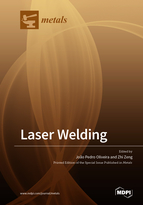Laser Welding
A special issue of Metals (ISSN 2075-4701).
Deadline for manuscript submissions: closed (31 March 2018) | Viewed by 102486
Special Issue Editors
Interests: advanced characterization; martensitic transformations; thermomechanical processing; welding; additive manufacturing
Special Issues, Collections and Topics in MDPI journals
Interests: laser welding; shape memory alloys; numerical modeling; stress and distortion; fatigue
Special Issues, Collections and Topics in MDPI journals
Special Issue Information
Dear Colleagues,
Laser welding is a high-energy process used in a wide range of advanced materials to obtain micro to macro sized joints in both similar and dissimilar combinations. Moreover, this technique is widely used in several industries such as automotive, aerospace, and medical industries as well as electrical devices. Although laser welding has been used for several decades now, significant and exciting innovations often arise from both the process and/or material’s side.
This Special Issue of Metals is dedicated to Laser Welding and aims to present new and recent developments related to this topic. Topics of interest include, but are not limited to: effects of laser welding on the material’s microstructure and performance; development of laser welding procedures for new advanced materials; modelling and simulation of laser/material interaction, thermal effects, stresses and distortion; hybrid laser welding. Papers which combine both experimental and theoretical approaches are specially welcomed.
Dr. João Pedro Oliveira
Prof. Dr. Zhi Zeng
Guest Editors
Manuscript Submission Information
Manuscripts should be submitted online at www.mdpi.com by registering and logging in to this website. Once you are registered, click here to go to the submission form. Manuscripts can be submitted until the deadline. All submissions that pass pre-check are peer-reviewed. Accepted papers will be published continuously in the journal (as soon as accepted) and will be listed together on the special issue website. Research articles, review articles as well as short communications are invited. For planned papers, a title and short abstract (about 100 words) can be sent to the Editorial Office for announcement on this website.
Submitted manuscripts should not have been published previously, nor be under consideration for publication elsewhere (except conference proceedings papers). All manuscripts are thoroughly refereed through a single-blind peer-review process. A guide for authors and other relevant information for submission of manuscripts is available on the Instructions for Authors page. Metals is an international peer-reviewed open access monthly journal published by MDPI.
Please visit the Instructions for Authors page before submitting a manuscript. The Article Processing Charge (APC) for publication in this open access journal is 2600 CHF (Swiss Francs). Submitted papers should be well formatted and use good English. Authors may use MDPI's English editing service prior to publication or during author revisions.
Keywords
Laser welding
Dissimilar joints
Microjoining
Structural characterization
Advanced materials
Microstructure
Mechanical behavior
Modelling and simulation
Laser welding robots







